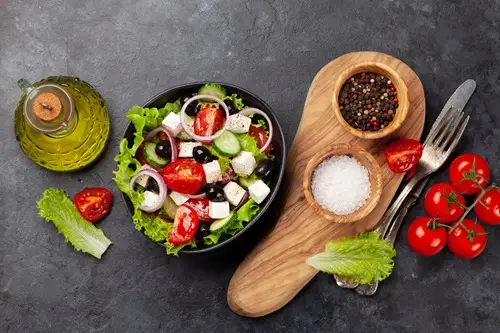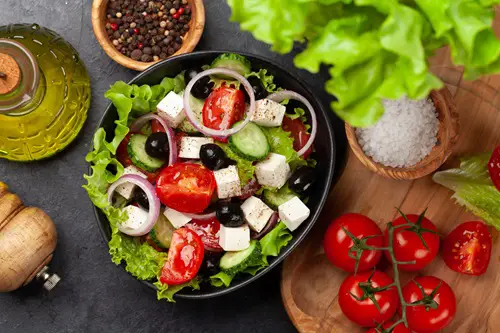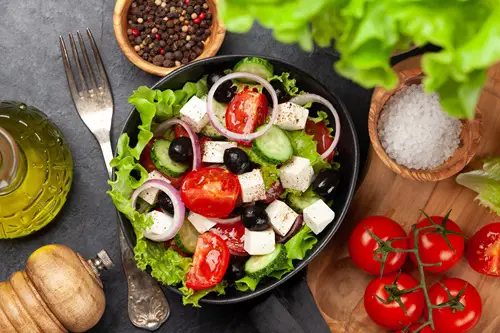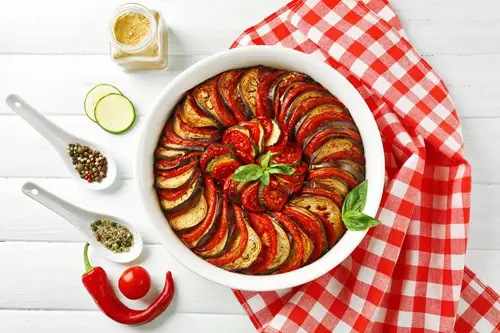As a busy mom of three kids—my eldest daughter, then my son, and my youngest daughter—finding recipes that are quick, healthy, and loved by everyone can sometimes feel like a miracle. There was this one summer day, not too long ago, when we had just returned from a hectic day at the beach. The kids were tired and hungry, and I needed something refreshing yet filling to serve. That’s when I remembered my go-to Greek Salad recipe. With minimal prep time and a burst of fresh flavors, it was the perfect solution to our post-beach hunger pangs.

The Versatility and Freshness of Greek Salad
One of the reasons I absolutely adore Greek Salad is its incredible versatility. Whether we’re having a casual family dinner or a spontaneous picnic in the backyard, this salad fits right in. The crisp cucumber, juicy tomatoes, and briny olives create a delightful mix of textures and flavors. Add to that the creamy feta cheese and the crunch of fresh lettuce, and you’ve got a salad that feels like a mini-vacation to the Mediterranean with each bite.
Why This Salad is a Family Favorite
In our household, Greek Salad has earned its spot as a family favorite for several reasons. First, it’s a dish that everyone, from my picky-eater son to my adventurous youngest daughter, enjoys. The kids love the simplicity of the ingredients, while I appreciate how nutritious and wholesome it is. Plus, it’s a great way to sneak in some extra veggies without any complaints.
The best part? It’s incredibly easy to customize. Some days, we add a handful of bell peppers or swap out lettuce for spinach. Other times, we sprinkle in some fresh herbs from our garden. No matter the variation, it always hits the spot. This recipe has become a staple in our meal rotation, and I’m excited to share it with you so it can become a favorite in your home too.

Importance of Quality Ingredients
When it comes to making a delicious Greek Salad, the quality of the ingredients can make all the difference. Here’s why it’s essential to choose fresh, high-quality components for this dish:
- Flavor: Fresh ingredients have a vibrant taste that really shines through in a salad. For instance, a ripe, juicy tomato will add sweetness and acidity, while a crisp cucumber offers refreshing crunch. Using fresh produce ensures that each bite is bursting with flavor, which is especially important in a simple salad like this.
- Nutrition: Quality ingredients are often more nutrient-dense. Fresh vegetables and fruits are packed with vitamins, minerals, and antioxidants that contribute to a healthy diet. Opting for organic or locally sourced produce can provide even more nutritional benefits, as they tend to be fresher and less likely to have been exposed to harmful pesticides.
- Texture: The texture of your salad is just as important as its flavor. Crisp lettuce, crunchy cucumbers, and creamy feta all contribute to a delightful mouthfeel. Fresh ingredients retain their texture better than older, wilted, or canned ones, resulting in a salad that’s not only tasty but also visually appealing.
- Color and Presentation: Fresh, high-quality ingredients add vibrant colors to your dish, making it more inviting. A beautiful salad with bright greens, deep reds, and creamy whites is not just a treat for the taste buds but also a feast for the eyes. Kids are often more inclined to try colorful dishes, making it easier to incorporate healthy eating habits into their lives.
- Seasonality: Using seasonal ingredients can enhance the taste of your salad. When produce is in season, it’s typically harvested at its peak ripeness, leading to superior flavor and texture. Additionally, choosing seasonal ingredients often means you’re supporting local farmers and reducing your carbon footprint.
By prioritizing quality ingredients in your Greek Salad, you’re not just creating a meal; you’re setting the stage for a nourishing and enjoyable dining experience for your family. Plus, it teaches your kids the value of fresh, whole foods, which is a lesson they’ll carry with them for a lifetime.

Greek Salad Ingredients
- 1 large cucumber, diced or sliced
- 4 cups lettuce leaves, torn or chopped (any variety, like romaine or mixed greens)
- 2 medium tomatoes, chopped
- 1 cup Kalamata olives, pitted and halved
- 1 cup feta cheese, crumbled
- 1 small red onion, thinly sliced
- 1/2 teaspoon black pepper
- 1/2 teaspoon salt (or to taste)
Feel free to adjust the measurements based on your family’s preferences!
Step-by-Step Instructions
Preparing the Vegetables
Start by gathering all your fresh ingredients. Rinse the cucumber, lettuce, and tomatoes under cold water to remove any dirt or residues. Dry them with a clean kitchen towel or paper towels to ensure that your salad doesn’t get soggy.
Cutting Techniques for Cucumber, Lettuce, Tomato, and Onion
- Cucumber: For a refreshing crunch, I like to peel the cucumber partially for a striped effect. Then, slice it in half lengthwise and scoop out the seeds with a spoon for less moisture. Finally, cut it into half-moons or cubes, depending on your preference.
- Lettuce: Tear the lettuce leaves into bite-sized pieces; this helps maintain their crispness. I often use a mix of romaine and green leaf lettuce for added texture and flavor.
- Tomato: Cut the tomatoes into wedges or chunks. If you’re using larger tomatoes, remove the seeds to prevent the salad from becoming watery.
- Onion: Slice the onion as thinly as possible for a milder flavor. I find that soaking the slices in cold water for about 10 minutes can help reduce their sharpness, making them more palatable for my kids.
Combining Ingredients in a Bowl
In a large salad bowl, gently toss the chopped cucumber, lettuce, tomatoes, and onion together. I like to use my hands for this to ensure everything is evenly distributed without bruising the veggies.
Adding Olives and Crumbling Feta Cheese
Next, sprinkle the halved olives over the salad. Crumble the feta cheese on top, allowing it to fall naturally into the salad. This adds a creamy texture that contrasts beautifully with the crisp vegetables.
Seasoning with Black Pepper and Salt
Finish with a sprinkle of black pepper and salt. Start with half a teaspoon of each, then taste and adjust as necessary. Sometimes I add a squeeze of fresh lemon juice for extra zing!
Tips and Variations
Tips for the Perfect Greek Salad
- Choosing the Right Type of Olives: Kalamata olives are a classic choice for Greek salad, offering a rich, briny flavor. If your kids are not fond of strong olive flavors, consider using mild green olives instead.
- Using Fresh Versus Dried Herbs: Fresh herbs, like parsley or oregano, can elevate your salad’s flavor profile. However, if you don’t have fresh herbs on hand, dried herbs work well too—just remember that dried herbs are more potent, so use them sparingly.
Variations to Try
- Adding Bell Peppers or Radishes: For extra crunch and color, try adding sliced bell peppers or thinly sliced radishes. They not only enhance the salad visually but also add unique flavors.
- Using Different Types of Lettuce: Experiment with various types of lettuce, such as arugula or butter lettuce, to change the salad’s texture and taste.
- Incorporating a Homemade Greek Dressing: For a zesty twist, drizzle your salad with a homemade Greek dressing made from olive oil, lemon juice, garlic, and oregano.
Health Benefits
- Cucumber: Hydrating and low in calories, cucumbers are an excellent source of vitamins K and C, as well as potassium.
- Lettuce: This leafy green is packed with fiber and essential nutrients while being low in calories, making it a fantastic base for any salad.
- Tomato: Rich in antioxidants like lycopene, tomatoes contribute to heart health and provide essential vitamins, including vitamin C.
- Olives: Packed with healthy fats, particularly monounsaturated fats, olives are also a good source of vitamin E and iron.
- Feta Cheese: A great source of protein and calcium, feta adds a creamy texture and rich flavor to the salad.
This Greek Salad fits beautifully into a balanced diet, providing a mix of healthy fats, vitamins, and minerals that nourish your family and promote overall well-being.

Serving Suggestions
Pairing Greek Salad with Other Dishes
Greek Salad pairs wonderfully with various main dishes. Serve it alongside grilled chicken or fish for a complete meal, or enjoy it with whole grain bread or pita for a light lunch.
Perfect Occasions for Serving Greek Salad
This salad is perfect for family dinners, as it can easily feed a crowd. It’s also an excellent choice for potlucks and picnics, where its fresh flavors shine, and it can be prepared ahead of time.
Storage and Leftovers
Best Practices for Storing Greek Salad
If you have leftovers, store them in an airtight container in the refrigerator. However, I recommend keeping the dressing separate until you’re ready to eat to prevent the salad from getting soggy.
How to Keep It Fresh for Longer
To maintain freshness, consume the salad within 2–3 days. If the lettuce starts to wilt, consider using it in a smoothie or a soup instead of tossing it out.
Ideas for Using Leftovers
Leftover Greek Salad can be repurposed in several delicious ways. Try mixing it into a wrap with some grilled chicken, or add it to a grain bowl with quinoa or farro for a satisfying meal.
I’d love to hear from you! What are your favorite Greek Salad variations? Do you have any tips or tricks that make this dish even better? Share your thoughts in the comments below, and feel free to tag me on social media if you give this recipe a try. Let’s inspire each other to create delicious meals for our families!
In conclusion, Greek Salad is not only simple and quick to prepare but also incredibly delicious and nutritious. Its fresh ingredients and vibrant flavors make it a perfect dish for any occasion. I encourage you to give this recipe a try—your family will love it just as much as mine does! Embrace the joy of cooking and the satisfaction of sharing wholesome meals with your loved ones. Happy cooking!
FAQs About Greek Salad
Can I make Greek Salad in advance?
Yes! You can prepare the salad ingredients in advance, but it’s best to keep the dressing separate until you’re ready to serve. This helps maintain the crispness of the vegetables.
What kind of olives should I use?
Kalamata olives are traditional for Greek Salad due to their rich flavor, but you can use any olives you prefer. Green olives or black olives also work well.
Can I add other vegetables to my Greek Salad?
Absolutely! Feel free to get creative. Bell peppers, radishes, or even avocado can add great flavor and texture to your salad.
Can I make a vegan version of Greek Salad?
Yes! Simply omit the feta cheese or replace it with a vegan cheese alternative. You can also add more beans or chickpeas for extra protein.
How long will leftovers last in the fridge?
Leftover Greek Salad will typically last for 2–3 days in the refrigerator if stored in an airtight container. However, the vegetables may start to lose their crispness after the first day.
u003cstrongu003eIs it necessary to peel the cucumber?u003c/strongu003e
Peeling the cucumber is optional. If you prefer a bit of crunch and color, you can leave the skin on. Just make sure to wash it thoroughly.
How can I make my Greek Salad more filling?
To make your salad more substantial, consider adding grilled chicken, chickpeas, or quinoa. These ingredients will enhance the protein content and make it a complete meal.
Greek Salad Recipe Card

Easy Greek Salad Recipe
Ingredients
- 1 large cucumber diced or sliced
- 4 cups lettuce leaves torn or chopped
- 2 medium tomatoes chopped
- 1 cup Kalamata olives pitted and halved
- 1 cup feta cheese crumbled
- 1 small red onion thinly sliced
- 1/2 teaspoon black pepper to taste
- 1/2 teaspoon salt to taste
- Optional: Fresh lemon juice or dried oregano for added flavor
Instructions
- Prepare the Vegetables: Rinse and dry the cucumber, lettuce, and tomatoes. Peel the cucumber partially, slice it lengthwise, and remove seeds. Tear the lettuce into bite-sized pieces, chop the tomatoes, and thinly slice the onion.
- Combine Ingredients: In a large salad bowl, gently toss the cucumber, lettuce, tomatoes, and onion together.
- Add Olives and Feta: Sprinkle the halved olives over the salad. Crumble the feta cheese on top.
- Season: Add black pepper and salt to taste. For extra flavor, consider adding a squeeze of fresh lemon juice or a sprinkle of dried oregano.
- Serve: Toss everything gently to combine, then serve immediately. Enjoy!






